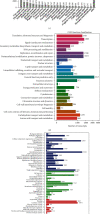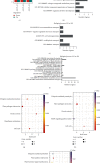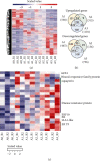A De Novo Transcriptome Analysis Identifies Cold-Responsive Genes in the Seeds of Taxillus chinensis (DC.) Danser
- PMID: 35845948
- PMCID: PMC9279050
- DOI: 10.1155/2022/9247169
A De Novo Transcriptome Analysis Identifies Cold-Responsive Genes in the Seeds of Taxillus chinensis (DC.) Danser
Abstract
Taxillus chinensis (DC.) Danser, a parasitic plant of the Loranthaceae family, grows by attacking other plants. It has a long history of being used in Chinese medicine to treat multiple chronic diseases. We previously observed that T. chinensis seeds are sensitive to cold. In this study, we performed transcriptome sequencing for T. chinensis seeds treated by cold (0°C) for 0 h, 12 h, 24 h, and 36 h. TRINITY assembled 257,870 transcripts from 223,512 genes. The GC content and N50 were calculated as 42.29% and 1,368, respectively. Then, we identified 42,183 CDSs and 35,268 likely proteins in the assembled transcriptome, which contained 1,622 signal peptides and 6,795 transmembrane domains. Next, we identified 17,217 genes (FPKM > 5) and 2,333 differentially expressed genes (DEGs) in T. chinensis seeds under cold stress. The MAPK pathway, as an early cold response, was significantly enriched by the DEGs in the T. chinensis seeds after 24 h of cold treatment. Known cold-responsive genes encoding abscisic acid-associated, aquaporin, C-repeat binding factor (CBF), cold-regulated protein, heat shock protein, protein kinase, ribosomal protein, transcription factor (TF), zinc finger protein, and ubiquitin were deregulated in the T. chinensis seeds under cold stress. Notably, the upregulation of CBF gene might be the consequences of the downregulation of MYB and GATA TFs. Additionally, we identified that genes encoding CDC20, YLS9, EXORDIUM, and AUX1 and wound-responsive family protein might be related to novel mechanisms of T. chinensis seeds exposed to cold. This study is first to report the differential transcriptional induction in T. chinensis seeds under cold stress. It will improve our understanding of parasitic plants in response to cold and provide a valuable resource for future studies.
Copyright © 2022 Jine Fu et al.
Conflict of interest statement
The authors declare that they have no competing interests.
Figures





Similar articles
-
Identification of MicroRNAs in Taxillus chinensis (DC.) Danser Seeds under Cold Stress.Biomed Res Int. 2021 May 30;2021:5585884. doi: 10.1155/2021/5585884. eCollection 2021. Biomed Res Int. 2021. PMID: 34159194 Free PMC article.
-
Transcriptome Analysis of Taxillusi chinensis (DC.) Danser Seeds in Response to Water Loss.PLoS One. 2017 Jan 3;12(1):e0169177. doi: 10.1371/journal.pone.0169177. eCollection 2017. PLoS One. 2017. PMID: 28046012 Free PMC article.
-
De novo Transcriptome Reveals Gene Changes in the Development of the Endosperm Chalazal Haustorium in Taxillus chinensis (DC.) Danser.Biomed Res Int. 2020 Feb 18;2020:7871918. doi: 10.1155/2020/7871918. eCollection 2020. Biomed Res Int. 2020. PMID: 32149138 Free PMC article.
-
Chromosome-Level Genome Assembly of the Hemiparasitic Taxillus chinensis (DC.) Danser.Genome Biol Evol. 2022 May 3;14(5):evac060. doi: 10.1093/gbe/evac060. Genome Biol Evol. 2022. PMID: 35482027 Free PMC article.
-
Taxillus chinensis (DC.) Danser: a comprehensive review on botany, traditional uses, phytochemistry, pharmacology, and toxicology.Chin Med. 2022 Dec 8;17(1):136. doi: 10.1186/s13020-022-00694-5. Chin Med. 2022. PMID: 36482376 Free PMC article. Review.
Cited by
-
Genome-Wide Analysis of ZAT Gene Family in Osmanthus fragrans and the Function Exploration of OfZAT35 in Cold Stress.Plants (Basel). 2023 Jun 16;12(12):2346. doi: 10.3390/plants12122346. Plants (Basel). 2023. PMID: 37375971 Free PMC article.
References
-
- Deng J. M., Jian L. C. Advances of studies on plant freezing-tolerance mechanism: freezing tolerance gene expression and its function. Chinese Bulletin of Botany . 2001;18(5):p. 521.
MeSH terms
LinkOut - more resources
Full Text Sources
Miscellaneous

